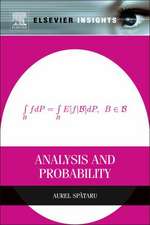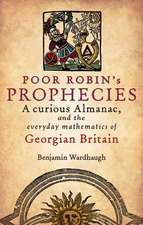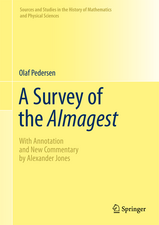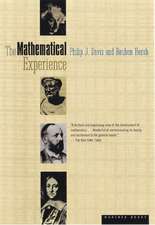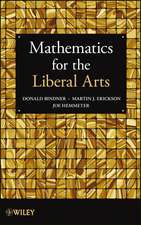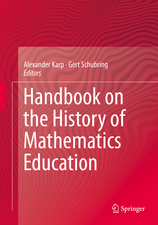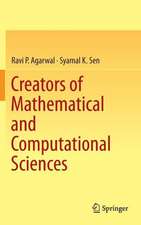String Figures as Mathematics?: An Anthropological Approach to String Figure-making in Oral Tradition Societies: Studies in History and Philosophy of Science, cartea 36
Autor Eric Vandendriesscheen Limba Engleză Hardback – 19 ian 2015
| Toate formatele și edițiile | Preț | Express |
|---|---|---|
| Paperback (1) | 617.15 lei 38-44 zile | |
| Springer International Publishing – 13 oct 2016 | 617.15 lei 38-44 zile | |
| Hardback (1) | 627.31 lei 6-8 săpt. | |
| Springer International Publishing – 19 ian 2015 | 627.31 lei 6-8 săpt. |
Din seria Studies in History and Philosophy of Science
- 15%
 Preț: 625.09 lei
Preț: 625.09 lei - 15%
 Preț: 673.68 lei
Preț: 673.68 lei -
 Preț: 295.64 lei
Preț: 295.64 lei -
 Preț: 375.07 lei
Preț: 375.07 lei - 18%
 Preț: 1175.35 lei
Preț: 1175.35 lei - 15%
 Preț: 622.11 lei
Preț: 622.11 lei - 15%
 Preț: 620.55 lei
Preț: 620.55 lei - 18%
 Preț: 919.21 lei
Preț: 919.21 lei - 18%
 Preț: 911.49 lei
Preț: 911.49 lei - 15%
 Preț: 621.17 lei
Preț: 621.17 lei - 15%
 Preț: 617.08 lei
Preț: 617.08 lei - 15%
 Preț: 619.61 lei
Preț: 619.61 lei - 18%
 Preț: 908.45 lei
Preț: 908.45 lei - 15%
 Preț: 622.42 lei
Preț: 622.42 lei - 18%
 Preț: 916.19 lei
Preț: 916.19 lei - 18%
 Preț: 910.11 lei
Preț: 910.11 lei - 18%
 Preț: 1324.87 lei
Preț: 1324.87 lei - 15%
 Preț: 613.18 lei
Preț: 613.18 lei - 15%
 Preț: 609.08 lei
Preț: 609.08 lei - 18%
 Preț: 1172.30 lei
Preț: 1172.30 lei - 24%
 Preț: 634.75 lei
Preț: 634.75 lei - 18%
 Preț: 923.93 lei
Preț: 923.93 lei - 15%
 Preț: 616.64 lei
Preț: 616.64 lei - 15%
 Preț: 617.89 lei
Preț: 617.89 lei - 15%
 Preț: 617.25 lei
Preț: 617.25 lei - 15%
 Preț: 617.08 lei
Preț: 617.08 lei - 15%
 Preț: 623.84 lei
Preț: 623.84 lei - 15%
 Preț: 614.60 lei
Preț: 614.60 lei - 18%
 Preț: 919.07 lei
Preț: 919.07 lei - 20%
 Preț: 622.06 lei
Preț: 622.06 lei - 15%
 Preț: 618.50 lei
Preț: 618.50 lei - 15%
 Preț: 619.91 lei
Preț: 619.91 lei - 15%
 Preț: 622.29 lei
Preț: 622.29 lei
Preț: 627.31 lei
Preț vechi: 738.01 lei
-15%
Puncte Express: 941
Preț estimativ în valută:
111.04€ • 129.73$ • 96.37£
111.04€ • 129.73$ • 96.37£
Carte tipărită la comandă
Livrare economică 25 februarie-11 martie
Preluare comenzi: 021 569.72.76
Specificații
ISBN-13: 9783319119939
ISBN-10: 3319119931
Pagini: 250
Ilustrații: XIX, 392 p. 1234 illus., 134 illus. in color.
Dimensiuni: 155 x 235 x 22 mm
Greutate: 0.75 kg
Ediția:2015
Editura: Springer International Publishing
Colecția Springer
Seria Studies in History and Philosophy of Science
Locul publicării:Cham, Switzerland
ISBN-10: 3319119931
Pagini: 250
Ilustrații: XIX, 392 p. 1234 illus., 134 illus. in color.
Dimensiuni: 155 x 235 x 22 mm
Greutate: 0.75 kg
Ediția:2015
Editura: Springer International Publishing
Colecția Springer
Seria Studies in History and Philosophy of Science
Locul publicării:Cham, Switzerland
Public țintă
ResearchCuprins
PART I: HOW TO STUDY STRING FIGURE-MAKING.- Chapter 1: String Figures and Ethnography.- Chapter 2: A Conceptualization of String Figure-Making.- PART II: MATHEMATICS AND STRING FIGURES.- Chapter 3: W.W. Rouse Ball’s Mathematical Approach to String Figures.- Chapter 4: Thomas Storer and the Concept of Heart-Sequence.- PART III: ANALYSING STRING FIGURE ALGORITHMS.- Chapter 5: Heart-Sequences and "Look-alike" String Figures.- Chapter 6: Understanding Transformations.- PART IV: STRING FIGURES IN THE FIELD.- Chapter 7: Cultural and Cognitive Aspects of String Figure-Making in Two Different Societies.- Chapter 8: Comparison of the Trobriander and Guarani-Nandeva String Figure Corpora.- Chapter 9: Conclusion.- References.- Annexes.
Recenzii
“Vandenessche (Paris Diderot Univ., France) dividesthe volume—which is really many books in one—into four parts: ‘How to StudyString Figure-Making,’ ‘Mathematics and String Figures,’ ‘Analysing StringFigure Algorithms,’ and ‘String Figures in the Field.’ … Summing Up: Highlyrecommended. Upper-division undergraduates through faculty and professionals.”(D. V. Feldman, Choice, Vol. 53 (3), November, 2015)
“Vandendriessche gives a mathematical analysis of string figure-making. … The author does recommend that every reader try following his instructions to create some of the string figures. I found his instructions clear and the multicolored pictures helpful. … Anthropologists and ethnomathematicians will benefit from the richness of Vandendriessche’s discussion.” (Joel Haack, MAA Reviews, March, 2015)
“Vandendriessche gives a mathematical analysis of string figure-making. … The author does recommend that every reader try following his instructions to create some of the string figures. I found his instructions clear and the multicolored pictures helpful. … Anthropologists and ethnomathematicians will benefit from the richness of Vandendriessche’s discussion.” (Joel Haack, MAA Reviews, March, 2015)
Notă biografică
Eric Vandendriessche has obtained the French "Agrégation" of mathematics (1992). In 2010, he received his Ph.D. in History and Philosophy of Sciences from Paris Diderot University. Eric Vandendriessche is a member of the Sciences–Philosophy–History French laboratory (UMR SPHERE 7219 – CNRS & Paris Diderot University). He is currently carrying out research in ethnomathematics, doing fieldwork in Papua New Guinea and Vanuatu (Melanesia, South Pacific). The aim of his work is to study the mathematical rationality that underlies activities involving geometrical and algorithmic practices (such as string figure-making or sand-drawing in Oceania), while attempting to analyze how the practitioners of these activities conceive - or have conceived - them in societies of oral tradition. Eric vandendriessche is in charge of the "String figures: cultural and cognitive aspects of a mathematical practice" research program (2012–2015), financially supported by the city of Paris (program "Emergences" 2011).
Textul de pe ultima copertă
This book addresses the mathematical rationality contained in the making of string figures. It does so by using interdisciplinary methods borrowed from anthropology, mathematics, history and philosophy of mathematics. The practice of string figure-making has long been carried out in many societies, and particularly in those of oral tradition. It consists in applying a succession of operations to a string (knotted into a loop), mostly using the fingers and sometimes the feet, the wrists or the mouth. This succession of operations is intended to generate a final figure. The book explores different modes of conceptualization of the practice of string figure-making and analyses various source material through these conceptual tools: it looks at research by mathematicians, as well as ethnographical publications, and personal fieldwork findings in the Chaco, Paraguay, and in the Trobriand Islands, Papua New Guinea, which all give evidence of the rationality that underlies this activity. It concludes that the creation of string figures may be seen as the result of intellectual processes, involving the elaboration of algorithms, and concepts such as operation, sub-procedure, iteration, and transformation.
Caracteristici
Shows how string figures appear to be the products of a mathematical activity Is relevant for researchers in anthropology, history and philosophy of science, mathematics, and ethnomathematics Includes a website giving the details of all procedures referred to in the book Includes supplementary material: sn.pub/extras

